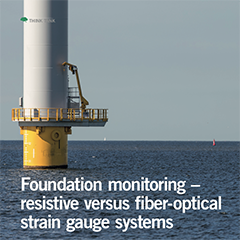The role foundations play in the deployment of larger, heavier, more powerful wind turbines, in deeper waters and further from shore, has perhaps not received the attention it deserves. But it is crucial in driving down offshore wind’s levelised cost of energy to the point where it can compete with fossil fuel and nuclear sources.
Technology and costs compared
Fixed foundations, whether monopile, jacket or gravity base designs, now support towers and turbines that weigh well over 1,000 tonnes and have a tip height of more than 200 metres. The foundations need to be able to do this, in high winds and heavy seas, for at least the 25 years of the turbine’s anticipated operating life.
Monitoring the structural integrity of the foundations, especially in the critical areas of greatest strain – just above and below the seabed – requires high expertise and state of the art test and measurement technology.
This is a field where industry development has outstripped design standards. There is no easy guide for offshore developers. In this report, technology leader HBM Test and Measurement compares resistive and fiber-optical gauge systems for offshore wind foundations.
To help design verification, or as a system to provide long-term assurance that the foundations in offshore wind turbines are in the intended condition, measurement in the foundations of offshore wind turbines is vital.
The place of greatest bending in the foundation typically lies where the structure meets the seabed. Measurements above and even below the seabed are possible, with the correct design and protection, using strain gauge technology. In monopiles this may consist of concentric rings of protected strain gauges placed around the circumference, inside the foundation. In gravity base structures and jackets, there are other ‘hotspots’.
These temperature-compensated measuring points route to a dedicated DAQ system for logging and − combined with readings from accelerometers, inclinometers and other sensors in the structure − provide a complete measurement system. This system then either works with the operator’s SCADA network or reports remotely via GSM or Satellite. Despite the technical challenges, the value of accurately measuring in the position where the structure faces its greatest forces, below the waterline, is great. Future standards may provide clarity on measurement types, location and logging frequency, but at present a lack of standards means that close technical liaison with those experienced in measurement in such harsh environments, particularly subsea, is key.



























